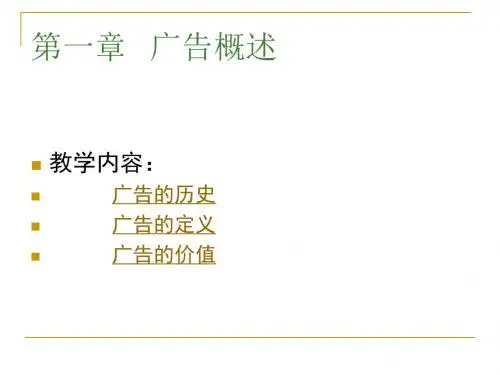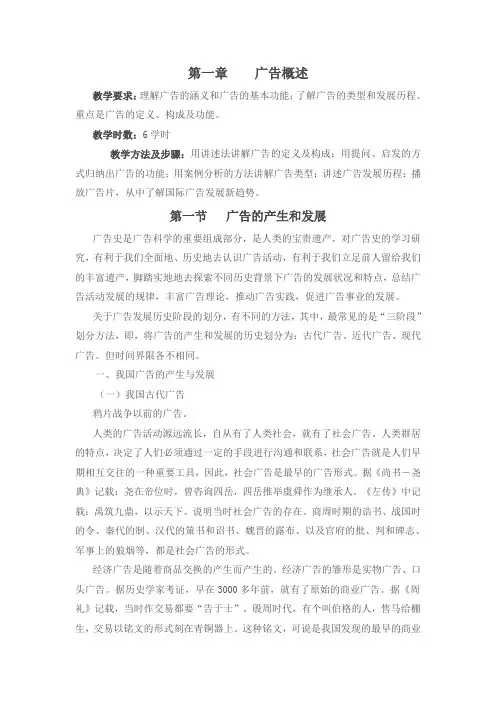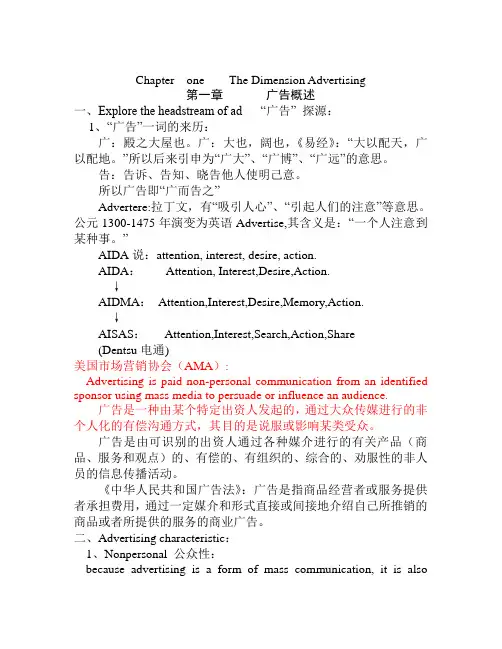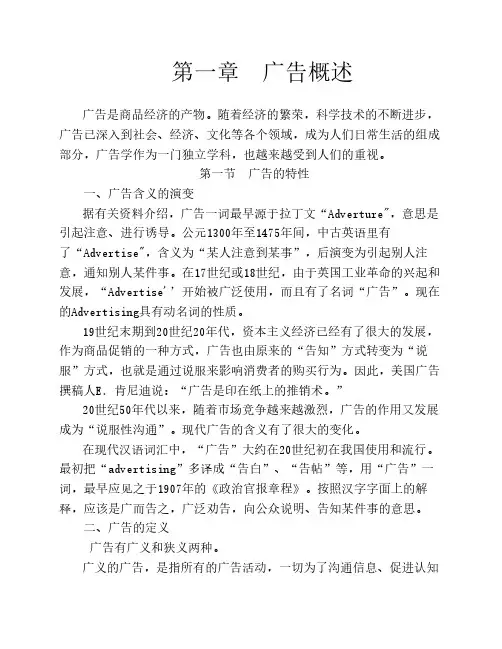第一章国际广告概述
- 格式:ppt
- 大小:2.39 MB
- 文档页数:25




第一章广告概述教学要求:理解广告的涵义和广告的基本功能;了解广告的类型和发展历程。
重点是广告的定义、构成及功能。
教学时数:6学时教学方法及步骤:用讲述法讲解广告的定义及构成;用提问、启发的方式归纳出广告的功能;用案例分析的方法讲解广告类型;讲述广告发展历程;播放广告片,从中了解国际广告发展新趋势。
第一节广告的产生和发展广告史是广告科学的重要组成部分,是人类的宝贵遗产,对广告史的学习研究,有利于我们全面地、历史地去认识广告活动,有利于我们立足前人留给我们的丰富遗产,脚踏实地地去探索不同历史背景下广告的发展状况和特点,总结广告活动发展的规律,丰富广告理论,推动广告实践,促进广告事业的发展。
关于广告发展历史阶段的划分,有不同的方法,其中,最常见的是“三阶段”划分方法,即,将广告的产生和发展的历史划分为:古代广告、近代广告、现代广告。
但时间界限各不相同。
一、我国广告的产生与发展(一)我国古代广告鸦片战争以前的广告。
人类的广告活动源远流长,自从有了人类社会,就有了社会广告。
人类群居的特点,决定了人们必须通过一定的手段进行沟通和联系,社会广告就是人们早期相互交往的一种重要工具,因此,社会广告是最早的广告形式。
据《尚书-尧典》记载:尧在帝位时,曾咨询四岳,四岳推举虞舜作为继承人。
《左传》中记载:禹筑九鼎,以示天下。
说明当时社会广告的存在。
商周时期的诰书、战国时的令、秦代的制、汉代的策书和诏书、魏晋的露布、以及官府的批、判和碑志、军事上的狼烟等,都是社会广告的形式。
经济广告是随着商品交换的产生而产生的。
经济广告的雏形是实物广告、口头广告。
据历史学家考证,早在3000多年前,就有了原始的商业广告。
据《周礼》记载,当时作交易都要“告于士”。
殷周时代,有个叫伯格的人,售马给棚生,交易以铭文的形式刻在青铜器上。
这种铭文,可说是我国发现的最早的商业广告。
在中国历史博物馆陈列的文物中,有一件周孝王时期的礼器,铭文记载了两个贵族因交易发生诉讼的情况。

Chapter one The Dimension Advertising第一章广告概述一、Explore the headstream of ad ―广告‖ 探源:1、―广告‖一词的来历:广:殿之大屋也。
广:大也,阔也,《易经》:―大以配天,广以配地。
‖所以后来引申为―广大‖、―广博‖、―广远‖的意思。
告:告诉、告知、晓告他人使明己意。
所以广告即―广而告之‖Advertere:拉丁文,有―吸引人心‖、―引起人们的注意‖等意思。
公元1300-1475年演变为英语Advertise,其含义是:―一个人注意到某种事。
‖AIDA说:attention, interest, desire, action.AIDA:Attention, Interest,Desire,Action.↓AIDMA:Attention,Interest,Desire,Memory,Action.↓AISAS:Attention,Interest,Search,Action,Share(Dentsu电通)美国市场营销协会(AMA):Advertising is paid non-personal communication from an identified sponsor using mass media to persuade or influence an audience.广告是一种由某个特定出资人发起的,通过大众传媒进行的非个人化的有偿沟通方式,其目的是说服或影响某类受众。
广告是由可识别的出资人通过各种媒介进行的有关产品(商品、服务和观点)的、有偿的、有组织的、综合的、劝服性的非人员的信息传播活动。
《中华人民共和国广告法》:广告是指商品经营者或服务提供者承担费用,通过一定媒介和形式直接或间接地介绍自己所推销的商品或者所提供的服务的商业广告。
二、Advertising characteristic:1、Nonpersonal 公众性:because advertising is a form of mass communication, it is alsononpersonal.2、Paid for by Sponsor /Advertiser:3、Persuasive 说服性In some cases the point of the message is simply to make consumer aware of the product or company, although most advertising tries to persuade or influence the consumer to do something.4、Advertising Information (Goods and Services) 广告信息:The message is conveyed through many different kinds of mass media reaching a large audience of potential consumers.5、Identified Sponsor/Advertiser特定的广告主:Advertiser is the individual or organization that initiates the advertising process.Types of Advertisers:(1)Manufacturers厂商/制造商:Manufacturers actually make the product or service and distribute it to resellers or ultimate users for a profit. They usually build their advertising around a product brand name.(2)Resellers转卖商、转售商:Resellers are wholesalers and retailers who distribute the manufacturers‘ products to other resellers or to the ultimate user.(3)Individuals个体广告商:An individual advertiser is a private citizen who wishes to sell a personal product for a profit, to request a particular need, or to express a perspective or an idea. For example, a college student selling a motorcycle would place a classified ad in the school newspaper.(4)Institutions机构广告商:The last group of advertisers includes institutions, government agencies, and social groups. They are distinguished from the other categories in that the primary objective is not to sell a product or generate profits but rather to raise issues, influence ideas, affect legislation, provide a social service, or change behavior in ways that are seen as socially desirable. Examples are Mother against drunk drivers (MADD).6、Mass MediaThe media are the channels of communication that carry the message from the advertising to the audience.The most frequently used ad media:Newspapers 报纸Television电视Radio /broadcast 广播Magazines杂志Out-of-home media户外媒体Direct response media直接反馈媒体7、Choosing Identified Customers /Target audience 广告对象/目标受众Consumers are people who buy or use products in order to satisfy needs and wants. There are actually two types of consumers: those who shop for and purchase the product, and those who actually use the product. This distinction is important because the two groups can have different needs and wants. In the case of children‘ cereals, for example parents (the purchasers) look for nutritional value, whereas children (the users) look for a sweet taste and a game on the back of package. 三、The classifies of advertising广告的分类Advertising is complex because so many diverse advertisers try to reach so many different types of audiences.(一)There are nine basic types of advertising:1、Brand Advertising品牌广告The most visible type of advertising is national consumer advertising. Another name for this is brand advertising, which focuses on the development of a long-term brand identity and image. It tries to develop a distinctive brand image for a product.2、Retail Advertising/Local Advertising零售广告/地方性广告:Retail advertising is local and focuses on the store where a variety of products can be purchased or where a service is offered. The message announces products that are available locally, stimulates store traffic, and tries to create a distinctive image for store. Retail advertising emphasizes price, availability, location, and hours of operation.3、Political Advertising政治广告:Political advertising is used by politicians to persuade people to vote for them and therefore is an important part of the political process in the United States and other democratic countries that permit candidate advertising. Although it is an important source of communication for voters, critics are concerned that politicaladvertising tends to focus more on image than on issues.4、Directory Advertising目录广告Another type of advertising is called directory because people refer to it to find out how to buy a product or service. The best-known form of directory advertising is Yellow Pages, although there are many different kinds of directories that perform the same function.5、Direct-Response Advertising直接反馈广告:Direct-response advertising can use any advertising medium, including direct mail, but the message is different from that of national and retail advertising in that it tries to stimulate a sale directly. The consumer can respond by phone or mail and the products are delivered directly to the consumer by mail or some other carrier.6、Business-to-Business Advertising企业间广告:Business-to-business advertising includes messages directed at retailers, wholesalers and distributors, as well as industrial purchasers and professionals such as lawyers and physicians. Business advertising tends to be concentrated in business publications or professional journals.7、Institutional Advertising机构广告:Institutional advertising is also called corporate advertising. The focus of these messages is on establishing a corporate identity or on winning the public over to the organization's point of view.8、Public Service Advertising(PSA)公益广告:Public service advertising(PSA)communicates a message on behalf of some good cause, such as stopping drunk driving(MADD) or preventing child abuse. These advertisements are created for free by advertising professionals, and the space and time are donated by media.9、Interactive Advertising互动广告It is a new type of advertising that focus on computer or Internet; you can get this kind of advertising from web page, such as flag Ad etc. The consumer can make direct feedback when they receive it, of course, they can put it on one side.(二)Other classifies of advertising 其他分类方法:1、According to the finally purpose 按广告的最终目的分类盈利性广告非盈利性广告2、According to content of advertising按广告的内容分类(1)Commercial advertising商业广告:经济广告Product advertising商品广告Examples of Product advertising商品广告示例Labor service advertising劳务广告patronage advertising形象广告Examples of patronage advertising形象广告示例(2)非商业广告:非经济广告Public service advertising公益广告Examples of public service advertising公益广告示例Public relation advertising公关广告Political Advertising政治广告3、According to advertising media按广告媒体分类(1)Printed Advertising印刷广告Examples of printed advertising印刷广告示例(2)Electronic advertising电子广告Examples of electronic advertising电子广告示例(3)Mail-order advertising邮寄广告Examples of outdoor advertising户外广告示例(4)Out-of-home advertising户外广告(5)Vehicle advertising交通工具广告Examples of vehicle advertising交通工具广告示例(6)Internet advertising网络广告4、According to advertising appeal广告诉求方式分类(1)Rational Appeal of Advertising 理性诉求广告(2)Emotional Appeal of Advertising 感性诉求广告(3)Compound Appeal of Advertising混合诉求广告5、According to geographic area 按地理区域划分(1)Local advertising地方性广告(2)Regional advertising区域性广告(3)National advertising全国性广告(4)International advertising国际广告6、According to target audience按目标受众划分(1)Consumer advertising消费者广告(2)BTB advertising工商广告(3)Trade advertising贸易广告(4)Professional advertising专业广告(5)Agricultural advertising农业广告四、Roles of advertising广告的作用1、Marketing RoleThe process a business uses to satisfy consumer needs by providing goods and services.Product category产品种类Target market目标市场Marketing mix 市场营销组合Brand品牌2、Communication RoleCan reach a mass audienceIntroduces productsExplains important changesReminds and reinforcesPersuades3、Economic RoleMoves from being informational to creating demand.Advertising is an objective means for providing price-value information, thereby creating a more rational economy4、Societal RoleInforms consumers about innovations and issues.Mirrors fashion and design trends反映流行和设计方式Teaches consumers about new productsHelps shape consumer self-imagePerpetuates self-expression使人难忘的自我表现五、Functions of Ad.广告的功能(一)Economic function经济功能Advertising is a persuasive communication tool used by marketers to transfer consumers‘ attention from the price of the product. Marketing communication(营销沟通): 向选定的目标受众传递相关营销信息的说服性沟通。




第一章 广告概述广告是商品经济的产物。
随着经济的繁荣,科学技术的不断进步,广告已深入到社会、经济、文化等各个领域,成为人们日常生活的组成部分,广告学作为一门独立学科,也越来越受到人们的重视。
第一节 广告的特性一、广告含义的演变据有关资料介绍,广告一词最早源于拉丁文“Adverture",意思是引起注意、进行诱导。
公元1300年至1475年间,中古英语里有了“Advertise",含义为“某人注意到某事”,后演变为引起别人注意,通知别人某件事。
在17世纪或18世纪,由于英国工业革命的兴起和发展,“Advertise'’开始被广泛使用,而且有了名词“广告”。
现在的Advertising具有动名词的性质。
19世纪末期到20世纪20年代,资本主义经济已经有了很大的发展,作为商品促销的一种方式,广告也由原来的“告知”方式转变为“说服”方式,也就是通过说服来影响消费者的购买行为。
因此,美国广告撰稿人E.肯尼迪说:“广告是印在纸上的推销术。
”20世纪50年代以来,随着市场竞争越来越激烈,广告的作用又发展成为“说服性沟通”。
现代广告的含义有了很大的变化。
在现代汉语词汇中,“广告”大约在20世纪初在我国使用和流行。
最初把“advertising”多译成“告白”、“告帖”等,用“广告”一词,最早应见之于1907年的《政治官报章程》。
按照汉字字面上的解释,应该是广而告之,广泛劝告,向公众说明、告知某件事的意思。
二、广告的定义广告有广义和狭义两种。
广义的广告,是指所有的广告活动,一切为了沟通信息、促进认知的广告形式都是广告,主要有商业广告与非商业广告。
商业广告——是指那些传递有关经济方面的信息、能够带来盈利的广告。
非商业广告——是指商业广告之外的一切广告。
如政府部门、社会团体发布的公告、声明、启事,个人传递的广告信息等,这些广告不是以盈利为目的。
如公益广告。
狭义的广告,是指商业广告。
本课主要介绍商业广告。

跨文化管理沟通之国际广告CATALOGUE目录•国际广告概述•跨文化管理沟通的基础•国际广告的跨文化策略•国际广告的跨文化实践•国际广告的跨文化挑战与解决方案•国际广告案例研究01国际广告概述定义特点定义与特点国际广告的背景与重要性背景全球经济一体化、国际贸易的蓬勃发展、消费者需求多样化。
重要性促进全球贸易、推动经济发展、提高品牌知名度、促进文化交流。
历史发展国际广告的历史与发展02跨文化管理沟通的基础文化的定义与特点文化的定义文化的特点由于不同文化背景下的价值观、信仰、知识、行为规范等方面存在差异,因此在跨文化沟通中可能会遇到语言障碍、误解、冲突等问题。
跨文化沟通的重要性随着全球化进程的加速,跨文化沟通在国际广告中的重要性日益凸显。
成功的跨文化广告能够精准地把握目标市场的文化特点,从而有效地传递信息、塑造品牌形象、提高品牌知名度。
跨文化沟通的挑战跨文化沟通的挑战与重要性VS尊重并理解目标市场的文化特点跨文化管理的策略与方法建立跨文化沟通机制培养跨文化管理人才灵活调整广告策略03国际广告的跨文化策略全球标准化策略总结词详细描述适应地方化策略总结词详细描述总结词整合营销沟通策略是一种将广告、公关、促销等多种营销手段相结合,以实现与消费者的有效沟通和互动的策略。
要点一要点二详细描述整合营销沟通策略的核心思想是,将广告、公关、促销等多种营销手段相结合,以实现与消费者的有效沟通和互动。
这种策略的优点是能够提高品牌知名度和忠诚度,促进销售增长。
但是,由于需要综合运用多种营销手段,这种策略的难度也相对较高。
整合营销沟通策略04国际广告的跨文化实践语言是文化的重要组成部分,不同的语言代表着不同的文化,对广告的接受程度和喜好也会有所不同。
总结词在国际广告中,语言与文化的差异常常带来许多挑战。
不同地区的语言表达方式和用词习惯存在差异,一些表达方式可能在某些文化中得到积极的响应,而在其他文化中则可能产生误解或反感。

第一章全球化——无国界的世界一.全球化:全球化是现代性从社会向世界的扩展,是现代性的基本制度特征向全球范围转变的必然结果。
全球化是一个以经济全球化为核心、包含各国各民族各地区在政治、文化、科技、军事、安全、意识形态、生活方式、价值观念等多层次、多领域的相互联系、影响、制约的多元概念。
三.经济全球化的动因:1.现代科学技术的发展和传播;2.发达国家的商品、资本的过剩和技术的超前,与其资源、能源、市场、廉价劳动力缺乏之间的矛盾;3.发展中国家为了缩小与发达国家在经济、技术和综合国力上的差距,无论是主动还是被动,都不得不投入到经济全球化浪潮中去。
五.国际化人才:指具有国际化意识和胸怀以及国际一流的知识结构,视野和能力达到国际化水准,在全球化竞争中善于把握机遇和争取主动的高次人才。
六.国际化人才应具备的素质:1.宽广的国际化视野和强烈的创新意识2.熟悉掌握本专业的国际化知识3.熟悉掌握国际惯例4.较强的跨文化沟通能力5.独立的国际活动能力6.较强的运用和处理信息的能力7.必须具备较高的政治思想素质和健康的心理素质,能经受多元文化的冲击,在做国际人的同时不至于丧失中华民族的人格和国格。
七.跨国公司理论背景:1.三大不平衡推动经济全球化:1.资源配置不平衡:自然资源等传统生产要素、科技创新等新型生产要素2.经济发展水平3.不同市场收益率不平衡:原材料、生产效率、人力成本、税收、营销费用2.垄断优势理论:在不完全的市场条件下,有些企业因为垄断而具有优势(如专利权,获得资本和市场的特殊能力,规模经济,产品特异化优势等),也有一些国家因为资源配置的不平衡具有区位优势。
3.市场内部化理论:内部化是指企业内部建立市场的过程,以企业的内部市场代替外部市场,从而解决由于市场不完整而带来的不能保证供需交换正常进行的问题。
八.内部化理论的三个基本假设:1.企业在不完全市场竞争中从事生产经营活动的目的是追求利润最大化;2.中间产品市场的不完全,使企业通过对外直接投资,在组织内部创造市场,以克服外部市场的缺陷;3.跨国公司是跨越国界的市场内部化过程的产物。
2023-11-06contents •国际广告概述•海外广告业务•国际广告及海外广告的业务流程•国际广告及海外广告的营销策略•国际广告及海外广告的案例分析•国际广告及海外广告的未来展望目录01国际广告概述定义与特点定义国际广告是指广告主通过跨国媒体向不同国家的受众传播产品、服务或品牌信息的广告活动。
特点跨国性、多元性、文化差异性和复杂性。
发展历程初始阶段20世纪初,国际广告以出口产品为主,跨国公司开始在国外媒体上投放广告。
发展阶段20世纪50年代以后,国际广告业逐渐成熟,跨国公司开始在海外市场建立分公司和办事处。
全球化阶段20世纪90年代以后,随着全球化的发展,国际广告业进入全球化时代,跨国公司开始在全球范围内进行广告投放。
行业现状与趋势行业现状国际广告业发展迅速,市场规模不断扩大,跨国公司数量不断增加,国际广告市场竞争日益激烈。
趋势数字化、数据化、智能化和本土化。
国际广告业正在向数字化转型,数字媒体成为主要传播渠道,数据分析和挖掘成为广告投放的重要依据。
同时,随着全球化的深入发展,国际广告业也在不断本土化,以满足不同国家和地区的文化差异和市场需求。
02海外广告业务海外广告是指由国内广告主在国外投放的广告,主要面向国外消费者。
定义按投放平台分为线上广告和线下广告;按目标受众分为国际品牌广告和本地化广告;按推广效果分为品牌广告和效果广告。
分类海外广告的定义与分类优势拓展国际市场,提升品牌知名度,获取更多潜在客户,增加销售额。
要点一要点二挑战文化差异、法律法规限制、市场环境不熟悉、预算限制等。
海外广告的优势与挑战随着跨境电商的发展,海外广告市场不断扩大,投放需求持续增长,技术进步推动广告精准定位和效果评估。
趋势个性化推荐、短视频和直播、社交媒体营销、数据驱动的营销策略等成为主流趋势。
现状海外广告的市场现状与趋势VS03国际广告及海外广告的业务流程前期策划与调研竞争环境分析了解竞争对手的广告策略、市场份额、产品特点等,以便在创意和执行中做出差异化。